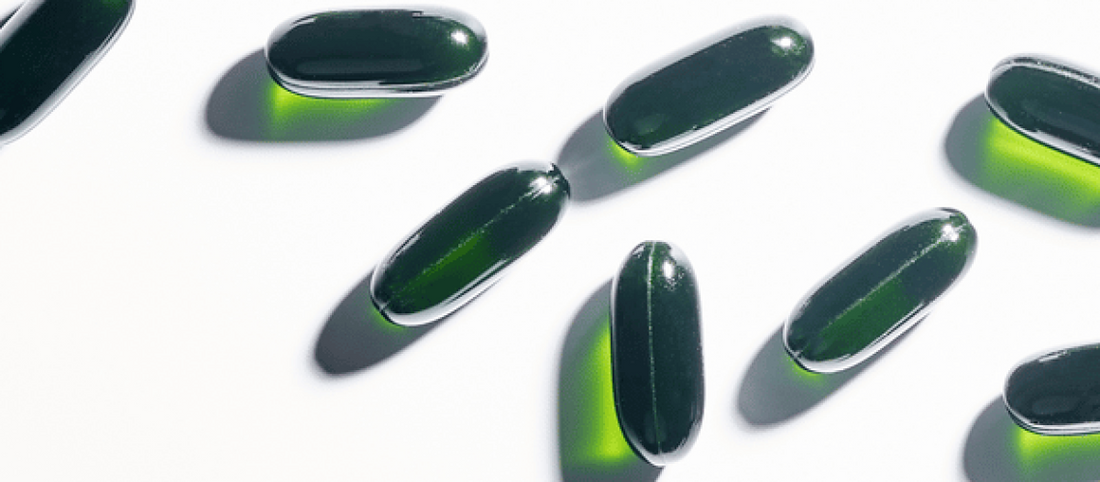There’s a lot of terminology thrown around when it comes to fish oil supplements. If you’ve ever wondered what all the terms mean and how to sift through what’s important vs jargon, we asked our naturopath Bec to shed some light on the subject…
What exactly is fish oil?
As the name suggests, fish oil is precisely that, oil that is extracted from fish. In the world of supplements, fish oil can come from many different species of fish, with the most common being salmon, anchovy, sardine and mackerel.
Fish oil is considered a ‘good fat’ thanks to its widely investigated health-promoting effects. There are around 30 different kinds of healthy fatty acids in fish oil, however, the most common is omega-3 fatty acids – making up around 30% of the fatty acid content of fish oil. These fatty acids are typically referred to as essential fatty acids (or EFAs), as the human body cannot make them, they must be consumed in the diet.
What are omega-3 fatty acids?
Fish oil naturally contains about one-third of its fatty acid content as the omega-3 fatty acids, eicosapentaenoic acid (EPA) and docosahexaenoic acid (DHA). These are the values we typically see represented on the labels of fish oil supplements. A standard omega-3 concentration of fish oil will be around 300mg per 1000mg of fish oil and this will be made up of approximately 180mg of EPA and 120mg of DHA.
What are EPA and DHA?
EPA and DHA are important components of cellular health. These fatty acids are incorporated into cell membranes in the human body to help keep them supple and healthy. Well-nourished cell membranes are more efficient at nutrient transport and other important cellular functions like energy production.
Both EPA and DHA have been shown to have an anti-inflammatory effect which can benefit a number of health conditions such as cardiovascular disease, circulatory health, cognition and pregnancy health. Low intake of dietary EPA and DHA has been connected to increased inflammatory processes as well as poor fetal development, general cardiovascular health, and risk of the development of Alzheimer’s disease (AD).[1]
DHA is particularly important for the brain, nervous system, eyesight (retina health) and pregnancy outcomes.
What is concentrated fish oil?
Where we can start to see differences between the various brands of fish oil available on the market is in the overall value of the concentration of omega-3 content.
For example, in our Omega+ formula, each 1000mg of fish oil contains 600mg of omega-3. This is double the amount typically found in standard fish oil.
Further differences can also be found when we look at the levels of EPA and DHA content in different omega-3 products. All fish oils will tend to have subtle variations in the EPA and DHA content depending on the source of the fish, manufacturing techniques and brand requirements. Some brands will choose to customise the concentrations of EPA and DHA dependent upon their products’ target health outcomes. For instance, Omega+ contains 100mg of EPA and 500mg of DHA per 1000mg. We specifically elected to use a high DHA concentrate due to its significant health benefits for the brain and nervous system.
The AquaCelle® Difference
In addition to the above considerations when selecting your ideal omega-3 supplement, it’s also worth considering absorption. After all, you can only benefit from what you actually absorb!
The problem with fish oil (omega-3) and other fat-soluble nutrients is that your digestive tract is naturally an aqueous (water) based environment, meaning absorption can sometimes be a challenge, particularly for anyone whose gut health may be compromised.
Omega+ contains a patented delivery technology called AquaCelle®, which optimises the formation of micelles, which are structures naturally produced in the digestive process to assist with the absorption of fats and fat-soluble substances like omega-3 fatty acids and fat-soluble vitamins like vitamin A, D, E and K.
AquaCelle® has been clinically shown in human pharmacokinetic studies to increase the absorption of omega-3 by over 600%.[2] This rapid absorption also helps with overcoming the ‘fishy burp’ issue that is common when supplementing with fish oil capsules.
Fish Oil Quality, Purity and Sustainability
A final important consideration when comparing fish oil products is of purity, quality and sustainable fishing practices. Fish oil, whilst a high-demand commodity that has potent health benefits, should not come at the expense of the planet, nor should contaminants place consumers at risk.
Omega+ uses a world-class source of omega-3 called VivoOmega™ TG Premium. Not only do they have some of the highest standards for purity and quality in the world, exceeding globally recognised standards (see Table 1), but they also have a commitment to sustainable fishing practices with innovative processes in place that keep their ecological footprint at a minimum. VivoOmega™’s manufacturing practices have been independently evaluated and certified by Friend of the Sea and MarinTrust, two of the leading global organisations for sustainable and responsible fishery management.
Choose your fish oils wisely
As you can see, not all fish oil products are created equal and it’s worthwhile to investigate the attributes of the supplement you decide to take to make sure it’s the cleanest, freshest and most suitable product for your needs.
It was important to us at myBrainCo. to have a fish oil omega-3 supplement that had a high DHA content to deliver optimal brain health support, with absorption technology to enhance its bioavailability and maximise customer benefit. But, it was equally important to source the cleanest and most ethically sourced fish oil.
.
.
.
.
.
.
REFERENCES
- Swanson D, et al. Omega-3 fatty acids EPA and DHA: health benefits throughout life. Adv Nutr. 2012 Jan;3(1):1-7.
- Bremmell KE, et al. A self-emulsifying Omega-3 ethyl ester formulation (AquaCelle) significantly improves eicosapentaenoic and docosahexaenoic acid bioavailability in healthy adults. Eur J Nutr 2020;59: 2729–2737.
